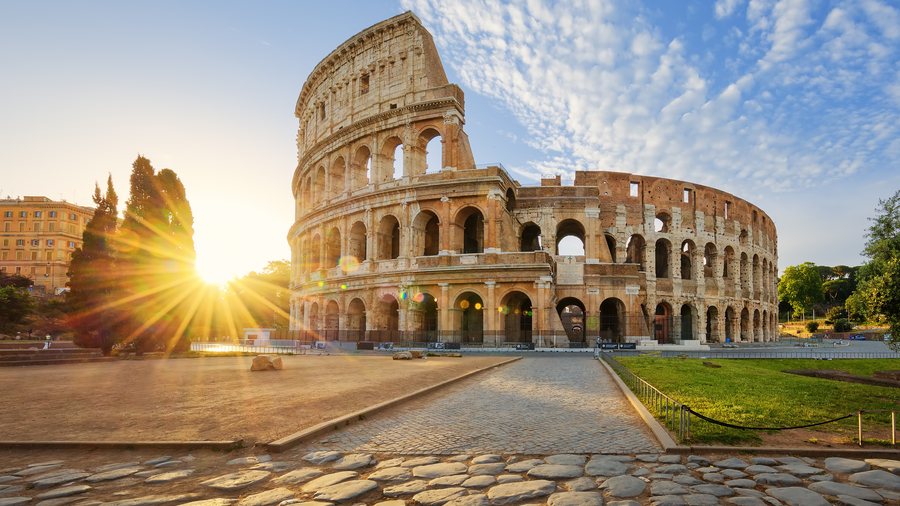When it comes to fascinating civilizations, the Roman Empire stands in a league of its own. Stretching from Britain to Egypt, Rome shaped politics, architecture, language, and culture for over a millennium. Today, the Eternal City still breathes life into that glorious past, with every ancient stone and piazza holding a secret or story waiting to be told.
Whether you’re a history buff or a curious traveler exploring Rome attractions, uncovering Roman history facts is like stepping through time—from gladiator battles in the Colosseum to the grandeur of imperial palaces. Let’s journey back through history and discover the most surprising, fun, and even strange facts about the Roman Empire.
1. Gladiators Weren’t Always Slaves
When people think of ancient Rome, gladiators instantly come to mind—muscular fighters clashing in the Colosseum before roaring crowds. But here’s one of the most fascinating Roman history facts: not all gladiators were slaves.
While many were indeed captives or criminals trained for combat, some were free men who volunteered to fight for fame and fortune. Successful gladiators became ancient celebrities, adored by the masses and often featured in advertisements for olive oil or wine!
To truly feel the echo of their battles, join a Colosseum Guided Tour and stand where these warriors once fought for glory under the gaze of emperors.
2. Roman Emperors Loved Their Public Image
Rome’s emperors were the ultimate influencers of their time. They used art, architecture, and even coins to spread their image across the empire. Statues, triumphal arches, and temples celebrated their victories and divine status.
One of the most impressive Rome attractions that showcases this imperial grandeur is the Pantheon, built by Emperor Hadrian. Its perfectly symmetrical dome remains the largest unreinforced concrete dome in the world—an architectural miracle even by today’s standards. To appreciate its genius, explore it with our Pantheon Audio Tour and let history come alive around you.
3. Romans Were Engineering Geniuses
If you’re walking through modern Rome and find yourself marveling at ancient ruins still standing strong, there’s a good reason. Roman engineers were ahead of their time. They invented concrete, built extensive road networks (“all roads lead to Rome” wasn’t just a saying!), and perfected aqueduct systems that carried fresh water across vast distances.
Among the most amazing Roman history facts is that some of these aqueducts still function today—over 2,000 years later! The Romans’ mastery of infrastructure helped their empire thrive, connecting millions of people across three continents.
4. Feasting Like an Emperor
Roman banquets were legendary affairs—sumptuous feasts featuring exotic delicacies like flamingo, dormice, and ostrich. The rich reclined on couches while servants brought dish after dish, often accompanied by plenty of wine.
Yet, daily life for ordinary Romans was simpler. Street vendors sold bread, olives, and the earliest versions of “fast food.” Supplì, pizza, and pasta all have roots in ancient Roman cuisine, evolving into the delicious meals we savor today.
If you’d like to taste modern Italy’s culinary legacy, join our Italian Culinary Experiences, where you can cook authentic Roman dishes inspired by centuries-old traditions.
5. The Emperors Were Worshipped Like Gods
Another captivating Roman history fact is how politics and religion intertwined in the Empire. After their deaths (and sometimes even while alive), emperors were declared divine and worshipped in temples. Augustus, Rome’s first emperor, was the pioneer of this practice, ensuring his legacy lived forever.
You can still visit the remains of these imperial temples scattered across Rome attractions, especially in the Roman Forum. Standing there, surrounded by crumbling marble and sunlit ruins, you can almost sense the divine aura that once captivated millions.
6. The Colosseum Could Be Flooded
Here’s one for your trivia collection: the Colosseum wasn’t just for gladiator fights—it also hosted naval battles! Engineers would flood the arena and stage elaborate mock sea wars, complete with ships and special effects.
Imagine standing in that massive amphitheater, hearing the splash of oars and the cheers of 50,000 spectators. It’s one of the most mind-blowing Roman history facts, showcasing just how advanced and theatrical Roman entertainment could be.
Experience it yourself with our Colosseum Guided Tour, where expert guides reveal the hidden mechanisms and stories that made this marvel possible.
7. The Roman Empire Never Truly Fell
While history books say the Western Roman Empire “fell” in 476 AD, many of its traditions never disappeared. The Eastern Empire, known as Byzantium, thrived for another thousand years. Roman laws, architecture, and even Latin evolved into the foundations of modern Europe.
In Rome, these traces remain everywhere—from ancient ruins to basilicas like St. Peter’s Basilica, which echoes the grandeur of imperial architecture. Walking through the city is like traversing centuries of history layered in stone, art, and faith.
8. Rome Was the World’s First “Global City”
At its peak, Rome was home to over a million people—a staggering number for the ancient world. Citizens came from across Europe, Africa, and Asia, making it one of history’s first truly multicultural capitals.
Markets buzzed with traders speaking dozens of languages, temples represented various gods, and ideas flowed freely. This melting pot of cultures helped shape art, cuisine, and innovation for generations. It’s no wonder that Rome’s attractions today reflect such incredible diversity and richness of heritage.
Conclusion: The Legacy Lives On
Two thousand years later, the spirit of the Roman Empire is still alive in the heart of Italy. From monumental ruins and royal palaces to cobblestone streets and bustling piazzas, every corner of Rome tells a story of power, innovation, and resilience.
Exploring these Roman history facts firsthand makes any visit to the Eternal City unforgettable. Whether you’re standing in the shadows of the Colosseum, wandering through the Pantheon, or joining one of our Rome Private Tours, you’re walking in the footsteps of emperors, poets, and gladiators.
Rome isn’t just a city—it’s a living museum, a time capsule of humanity’s greatest empire.






